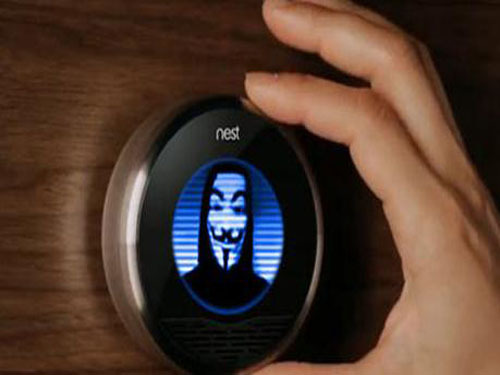Nests are becoming new tools for hacking
"HelloDave" High-power LED Lamp Beads are a kind of LED Lamp Beads. Compared with low-power LED lamp beads, high-power LED lamp beads have higher power, brighter brightness and higher price. Low-power LED lamp beads have a rated current of 20mA, and those with a rated current higher than 20mA can basically be counted as high-power. The general power numbers are: 0.25w, 0.5w, 1w, 3w, 5w, 8w, 10w and so on. The main brightness unit is lm (lumens), and the low-power brightness unit is generally mcd (millicandela, 1cd=1000mcd), which is the luminous intensity I. High-power lamp beads generally refer to imitated lumen lamp beads, just like the shape of a picture. SMD's are higher than 20MA. It is not called high power. Smd Led 2835 Lamp Beads,High Power Lamp Beads,Highlight Warm White Glow,High-Power Purple Lamp Beads Dongguan XINYUDA Technology Co., Ltd. , https://www.gdxige.com
If one day, you find such a "greeting" on your smart home thermostat, how do you feel? Don't panic, yes, hackers are watching you.
On August 11, technology media techcrunch reported that at the Black Hat Security Conference held this week, hackers easily invaded the Google Nest smart thermostat.
As we all know, Nest thermostat is Google's pioneer in the smart home market. Can adjust the user's indoor lighting, control the home room temperature, it can be in the "Internet of things" environment through networking and other devices connected. however. This is more closely related to life. This is even more vulnerable to hackers. At the same time, the smart home represented by Nest has caused people to think about it.
“Blackout Smart Devices is the theme of this year (Black Hat Security Conference),†said Daniel Buentello, a research fellow at the University of Florida, “This is a very fragile area where users cannot be installed on a computer. Anti-virus software is like protecting yourself. What's worse is that this is a secret back door, as long as they think, people with speculation can use your smart home, have been watching you, it is just as annoying as a fly on the wall.†.
It is understood that this smart home brand acquired by Google for USD 3.2 billion can identify whether the user is at home by using sensors installed in the home, and automatically adjust the optimal room temperature to ensure that the indoor temperature is appropriate; when people are not at home, Nest It will automatically adjust the air conditioning or electric heating to a low energy level, so as to ensure that all appliances in the home are in a state of energy saving. However, due to the above-mentioned home ecology needs to be connected to the network to achieve, so this has become the main reason for hackers eyeing smart home devices.
In addition, Nest also supports Wi-Fi networking - it is through this function, Nest can receive data from different sensors, real-time updates and feedback energy consumption data, and its storage space can reach a maximum size of 2G. At the same time, it is also equipped with two specialized sensors in order to be able to sense indoor personnel activities and use it as a basis for judging whether there is someone at home.
At the conference, Buentello showed us the whole process of being hacked: Through USB device access, users will upload all their own consumer passwords to this USB device. Hackers only need to know the correct boot code and they are free to do so. Load your own software, but in the whole process, there is no certification chain security measures to appear to be certified.
"This makes them (smart homes) become the freshest prey," the researchers said, this is like your own turn in each updated password, no matter what the move, the hackers will get the corresponding "sync." At the same time, although the virus needs to be in direct contact with Nest, it is not difficult for hackers to pre-install such software before shipping the product. What's more, hackers can also reset Nest at any time based on the data returned, such as weather information. In short, "I really want to do anything."
1cd=1 lm/sr (lumens/three-dimensional radian)=1 candlelight. It is explained as: the luminous flux emitted by the light source within the solid angle dΩ in the specified direction or the luminous flux dΦ transmitted by the obtained light source, the quotient of the two is the luminous intensity I (unit is candela, cd). The outer cover can be made of PC tube, which can withstand high temperature up to 135 degrees. PC tube made of LED cover, the internal temperature can reach 135 degrees, and the external temperature can resist -45 degrees without cracking
As an emerging green, environmentally friendly, energy-saving light source, it is widely used in car lights, flashlights, lamps and other places. The reason why LED high-power is called this is mainly for low-power LEDs. I have summarized three classification standards: The first one is that according to the power size can be divided into 0.5W, 1W, 3W, 5W, 10W... 100W varies, depending on the total power of the molded product after packaging.
The second type can be divided into different packaging processes: large-size epoxy resin packaging, piranha-like epoxy resin packaging, aluminum substrate (MCPCB) packaging, TO packaging, power SMD packaging, MCPCB integrated packaging, etc.
The third type can be divided into low-light-attenuation high-power products and non-low-light-attenuation high-power products according to its different degrees of light attenuation.
Of course, since there are many parameters of high-power LEDs, there will be different classification standards according to different parameters, so I will not repeat them here.
High-power LED lamp beads white light
High-power LED lamp beads white light
LED high-power is still one of the LED packaging products, and it is the most important part in the field of general lighting for semiconductor lighting.